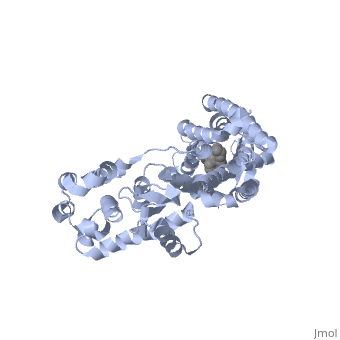4ej4: Difference between revisions
No edit summary |
No edit summary |
||
| Line 4: | Line 4: | ||
== Structural highlights == | == Structural highlights == | ||
<table><tr><td colspan='2'>[[4ej4]] is a 1 chain structure with sequence from [https://en.wikipedia.org/wiki/Escherichia_virus_T4 Escherichia virus T4] and [https://en.wikipedia.org/wiki/Mus_musculus Mus musculus]. Full crystallographic information is available from [http://oca.weizmann.ac.il/oca-bin/ocashort?id=4EJ4 OCA]. For a <b>guided tour on the structure components</b> use [https://proteopedia.org/fgij/fg.htm?mol=4EJ4 FirstGlance]. <br> | <table><tr><td colspan='2'>[[4ej4]] is a 1 chain structure with sequence from [https://en.wikipedia.org/wiki/Escherichia_virus_T4 Escherichia virus T4] and [https://en.wikipedia.org/wiki/Mus_musculus Mus musculus]. Full crystallographic information is available from [http://oca.weizmann.ac.il/oca-bin/ocashort?id=4EJ4 OCA]. For a <b>guided tour on the structure components</b> use [https://proteopedia.org/fgij/fg.htm?mol=4EJ4 FirstGlance]. <br> | ||
</td></tr><tr id='ligand'><td class="sblockLbl"><b>[[Ligand|Ligands:]]</b></td><td class="sblockDat" id="ligandDat"><scene name='pdbligand=EJ4:(4BS,8R,8AS,14BR)-7-(CYCLOPROPYLMETHYL)-5,6,7,8,14,14B-HEXAHYDRO-4,8-METHANO[1]BENZOFURO[2,3-A]PYRIDO[4,3-B]CARBAZOLE-1,8A(9H)-DIOL'>EJ4</scene></td></tr> | </td></tr><tr id='method'><td class="sblockLbl"><b>[[Empirical_models|Method:]]</b></td><td class="sblockDat" id="methodDat">X-ray diffraction, [[Resolution|Resolution]] 3.4Å</td></tr> | ||
<tr id='ligand'><td class="sblockLbl"><b>[[Ligand|Ligands:]]</b></td><td class="sblockDat" id="ligandDat"><scene name='pdbligand=EJ4:(4BS,8R,8AS,14BR)-7-(CYCLOPROPYLMETHYL)-5,6,7,8,14,14B-HEXAHYDRO-4,8-METHANO[1]BENZOFURO[2,3-A]PYRIDO[4,3-B]CARBAZOLE-1,8A(9H)-DIOL'>EJ4</scene></td></tr> | |||
<tr id='resources'><td class="sblockLbl"><b>Resources:</b></td><td class="sblockDat"><span class='plainlinks'>[https://proteopedia.org/fgij/fg.htm?mol=4ej4 FirstGlance], [http://oca.weizmann.ac.il/oca-bin/ocaids?id=4ej4 OCA], [https://pdbe.org/4ej4 PDBe], [https://www.rcsb.org/pdb/explore.do?structureId=4ej4 RCSB], [https://www.ebi.ac.uk/pdbsum/4ej4 PDBsum], [https://prosat.h-its.org/prosat/prosatexe?pdbcode=4ej4 ProSAT]</span></td></tr> | <tr id='resources'><td class="sblockLbl"><b>Resources:</b></td><td class="sblockDat"><span class='plainlinks'>[https://proteopedia.org/fgij/fg.htm?mol=4ej4 FirstGlance], [http://oca.weizmann.ac.il/oca-bin/ocaids?id=4ej4 OCA], [https://pdbe.org/4ej4 PDBe], [https://www.rcsb.org/pdb/explore.do?structureId=4ej4 RCSB], [https://www.ebi.ac.uk/pdbsum/4ej4 PDBsum], [https://prosat.h-its.org/prosat/prosatexe?pdbcode=4ej4 ProSAT]</span></td></tr> | ||
</table> | </table> | ||
== Function == | == Function == | ||
[https://www.uniprot.org/uniprot/OPRD_MOUSE OPRD_MOUSE] G-protein coupled receptor that functions as receptor for endogenous enkephalins and for a subset of other opioids. Ligand binding causes a conformation change that triggers signaling via guanine nucleotide-binding proteins (G proteins) and modulates the activity of down-stream effectors, such as adenylate cyclase. Signaling leads to the inhibition of adenylate cyclase activity. Inhibits neurotransmitter release by reducing calcium ion currents and increasing potassium ion conductance. Plays a role in the perception of pain and in opiate-mediated analgesia. Plays a role in developing analgesic tolerance to morphine.<ref>PMID:10677041</ref> <ref>PMID:1334555</ref> <ref>PMID:1335167</ref> [https://www.uniprot.org/uniprot/ENLYS_BPT4 ENLYS_BPT4] Endolysin with lysozyme activity that degrades host peptidoglycans and participates with the holin and spanin proteins in the sequential events which lead to the programmed host cell lysis releasing the mature viral particles. Once the holin has permeabilized the host cell membrane, the endolysin can reach the periplasm and break down the peptidoglycan layer.<ref>PMID:22389108</ref> | |||
==See Also== | ==See Also== | ||
Revision as of 18:02, 14 March 2024
Structure of the delta opioid receptor bound to naltrindoleStructure of the delta opioid receptor bound to naltrindole
Structural highlights
FunctionOPRD_MOUSE G-protein coupled receptor that functions as receptor for endogenous enkephalins and for a subset of other opioids. Ligand binding causes a conformation change that triggers signaling via guanine nucleotide-binding proteins (G proteins) and modulates the activity of down-stream effectors, such as adenylate cyclase. Signaling leads to the inhibition of adenylate cyclase activity. Inhibits neurotransmitter release by reducing calcium ion currents and increasing potassium ion conductance. Plays a role in the perception of pain and in opiate-mediated analgesia. Plays a role in developing analgesic tolerance to morphine.[1] [2] [3] ENLYS_BPT4 Endolysin with lysozyme activity that degrades host peptidoglycans and participates with the holin and spanin proteins in the sequential events which lead to the programmed host cell lysis releasing the mature viral particles. Once the holin has permeabilized the host cell membrane, the endolysin can reach the periplasm and break down the peptidoglycan layer.[4] See AlsoReferences
|
| ||||||||||||||||||
